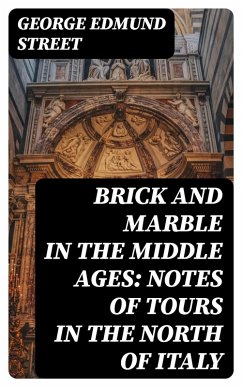In 'Brick and Marble in the Middle Ages: Notes of Tours in the North of Italy,' George Edmund Street immerses readers in a meticulous architectural journey, exploring the contrasting use of brick and marble in Italian medieval structures. Street's narrative, fluent and rich with historical context, systematically catalogues the region's ecclesiastical, civic, and military buildings, while also examining the stylistic nuances and material choices that defined the era's architectural vernacular. His prose incorporates a detailed literary style that not only informs but also reflects upon the cultural and societal implications of architectural form and technique during the Middle Ages, positioning this work within a web of historical treatises on art and architecture. In examining the author's background, one discerns that as a leading British architect in the Gothic Revival style, George Edmund Street wielded profound expertise in his analysis of medieval building design and construction. His extensive travels through Italy, underpinned by a fervent appreciation for Gothic and Romanesque traditions, undoubtedly fueled his scholarly narrative. The impetus for such a work likely stems from his desire both to document the endangered architectural heritage and to influence contemporary Victorian design by emphasizing lessons drawn from history. This classic text will beguile not only architectural historians but also those intrigued by Italian culture, medieval history, and heritage conservation. 'Brick and Marble in the Middle Ages' transcends mere travelogue to serve as a lasting scholarly resource, offering nuanced insights into Italy's venerable stone tapestry. Street's meticulous research and devoted observation render this book an indispensable addition to the libraries of those who cherish the grand narratives of architectural evolution and the intricate stories told by aging edifices of a bygone era.
Dieser Download kann aus rechtlichen Gründen nur mit Rechnungsadresse in A, B, BG, CY, CZ, D, DK, EW, E, FIN, F, GR, H, IRL, I, LT, L, LR, M, NL, PL, P, R, S, SLO, SK ausgeliefert werden.









